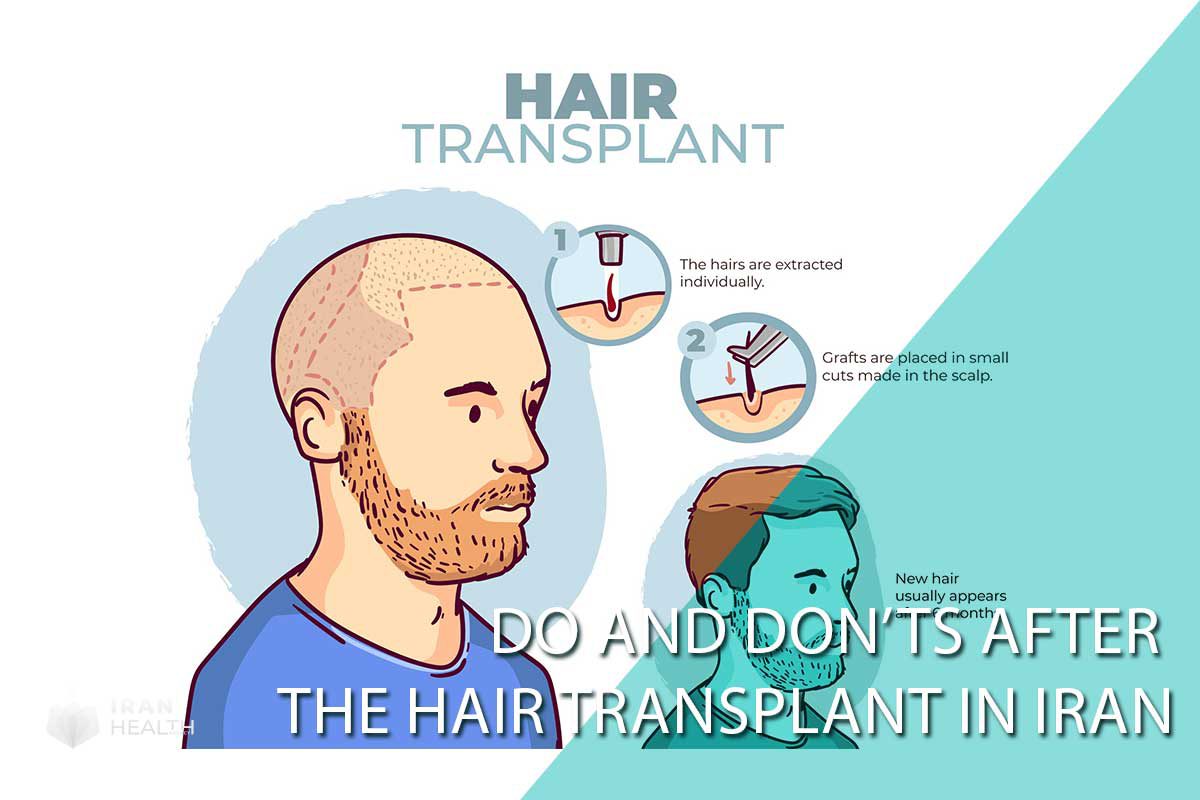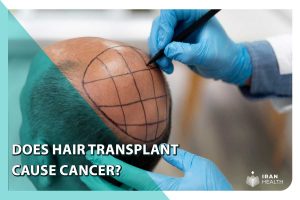Hair transplantation is a delicate cosmetic procedure and it is necessary to follow the doctor’s instructions correctly to achieve optimal results. In order to recover faster and get the best results, you should pay attention to such things after the hair transplant in Iran as nutrition, head washing, hair care, sleeping, use of drugs, etc. You should also know about the hair transplant recovery process and how to manage this procedure’s side effects of hair transplant in Iran. In this article, we have discussed the do’s and don’ts of hair transplantation; So, join us.
Dressing of the scalp after hair transplantation
At the end of the hair transplant operation, the patient’s head is bandaged. The dressing protects the implanted hair and creates a feeling of security and comfort. Taking care of the dressing, especially at night while sleeping, is very important. Pulling the dressing on the scalp causes the hair to come out of the implant site. Of course, this can also happen during the day, for example, the patient’s head may hit the door while getting in the car and a number of hairs may be pulled out. So you should take care of the dressing to prevent any damage to the implanted hair.
The day after the operation, the dressing is removed at the hair transplant clinic and the hair is washed with shampoo and re-dressed. Then, with the instructions given to the patient, the hair shampooing continues at home. With a little training, patients can change their dressing at home on their own. It is recommended that patients have a 24-hour dressing in the first week. The dressing needs to be changed every day.
The recovery process after hair transplantation
Most patients feel better within a day or two after surgery, although there may be some numbness and mild pain for a few days after surgery. During the recovery period after surgery, you will see red spots on your transplant area that disappear after 7-10 days. Patients usually regain their normal appearance within 15 days after hair transplant. Slight redness of the scalp may persist for a longer time; however, prolonged redness is more common in people with lighter skin.
The transplanted hair may begin to fall out after 15 days, and hair loss may continue for the first two months. The transplanted hair follicles are still inside the scalp and the new hair shaft will continue to grow under the skin and reach its surface within 3-4 months. About 6 months later, the initial result will appear and hair density increases. It takes 10-12 months to see the expected result of this cosmetic procedure when the hair grows at an average speed of 1.5 cm per month.
People who have had hair loss and used minoxidil drops before implantation can resume taking the drug two weeks after surgery when the wounds have completely healed. Even Minoxidil may prevent hair loss during the resting phase and hair regrowth may begin sooner. Minoxidil helps heal wounds.
Also, keep in mind that the rate of hair regrowth varies from person to person and from one area to another. For example, hair may be thicker in one area than in other areas, but as hair continues to grow, the distribution of hair becomes more uniform.
related post:
How to sleep after a hair transplant
We recommend you complete rest on the day after the hair transplant. To sleep properly, place two pillows under your head so that the head is at a 30-degree angle. Preferably lie on your back with your chest and abdomen facing up. This condition reduces any swelling that may occur in your scalp after hair transplantation. If you cannot sleep in this position, sleep on the right or left side. It is also recommended to protect your newly implanted hair while sleeping with a travel pillow. Note that enough sleep is important to help the healing process and hair growth.
Pain management after hair transplant
Mild pain can be felt for several days after the hair transplant. Some people have trouble sleeping during the first few days after surgery. To relieve pain, common painkillers such as acetaminophen, ibuprofen, or other nonsteroidal anti-inflammatory drugs can be used if your doctor prescribes them.
Swelling after hair transplantation
Slight swelling may occur on the forehead and around the eyes and may continue for 2-5 days after hair transplantation. Sometimes this swelling is accompanied by a slight bruising. Of course, there is no need to worry. Swelling after hair transplantation is completely natural and there is no danger to the transplanted hair or the person’s health.
If you experience this complication, you can put an ice pack on your forehead and eyes on the first night after implantation. Do not do this if you have sinusitis. To do this correctly, you can do this every hour for 20 minutes. Note that each time you hold the ice on your forehead for a maximum of 1 minute.
Please note that in any case, you should not use ice packs for your recipient and donor areas of hair transplantation. This swelling is not dangerous and usually goes away without the need for any medication. Of course, your doctor might prescribe anti-inflammatory pills as a precaution.
In some patients, who have to come to work earlier, swelling can be largely prevented by prescribing corticosteroids in the form of prednisolone tablets or injecting dexamethasone injections.
Interesting post:
Scaling, itching, and bleeding after hair transplantation
About 7-10 days after the hair transplant, there should be no more traces of dried blood, scars, or scales on your scalp. If there are still scales after 7 days, gently remove them when washing your hair. Remember you should not try to remove blood stains that are dry and stick to the scalp with nails or with high-pressure water.
After the hair transplant, your scalp will itch. This is a very common condition and usually lasts for 10-15 days. You should never steam your recipient and donor areas as this can adversely affect the results.
After a hair transplant, you may notice a small amount of fluid, including some blood, on your pillow. Do not worry, this is not dangerous, it is just an injected fluid that comes out of your scalp during the operation.
How to wash your hair after a hair transplant
The most important day for hair transplantation is the first day. In the first few days after transplantation, the hair strands are adapting to their new location. Cleaning the skin around the implant is very important because it helps new hair to grow. Washing the head not only does not cause infection but also prevents infection and dandruff and fat accumulation.
Your doctor will prescribe a special shampoo and lotion to wash your head daily for about 2 weeks after your hair transplant. Hair washing is done in 3 easy steps:
- Start by applying (without rubbing), the lotion gently to the recipient area for about 45 minutes. This will help heal the wounds around the implanted hair. After 45 minutes, rinse the lotion with lukewarm water.
- Wash the donor and recipient areas with a special shampoo. To do this, apply a small amount of shampoo on the palm of your hand and gently rub it all over your scalp. Gently wash the grafted area with your fingertips. You can also massage the donor area to increase blood circulation. Then wash the shampoo thoroughly from your scalp. It is also forbidden to stand under a normal high-pressure shower for up to two weeks because the implanted hair is loose and may be torn off by water pressure.
- After washing, gently dry your hair with a paper towel. Only use paper towels as they are soft and do not damage the implanted hair. A hot hair dryer is harmful to hair and should not be used. It is best to apply an antibiotic ointment such as gentamicin on wounds before re-dressing.
To get rid of wounds and dry blood, these three steps should be repeated every day for 14 days. After 14 days, you can start washing your hair as usual with regular shampoo or baby shampoo.
If the beard is used as a donor area, the beard can be shaved after a week. The donor area usually heals completely within a month.
Nutrition after hair transplantation
It is recommended to take a multivitamin in the morning after hair transplantation at breakfast and continue regularly; Include vitamin C-rich fluids and fruits in your diets, such as pineapple and oranges. If prescribed by your doctor, take cephalexin every 6 hours and take regular zinc tablets.
Haircare after hair transplantation
Avoid straightening, curling, and blow-drying your hair regularly; After a month, you can comb your hair in only one direction. If you need to dye your hair from the second month onwards, do this. You should use the prescribed shampoo for washing up to one month after planting, then you can use any appropriate shampoo for your scalp.
Physical activity, sun, and travel after hair transplant
In the first month after hair transplantation, you should refrain from all physical activities such as football, basketball, or any other type of intense physical activity, as well as weightlifting, cycling, and running.
After hair transplantation, complete rest in bed is not necessary. It is recommended that patients rest at home for only one or two days.
Patients should try to avoid sudden and severe bending of the neck in the first few weeks after FUT, which causes the scalp to stretch so that the suture may widen. Those who have had a non-surgical FUE (FIT) hair transplant have no restrictions on bending their necks and can resume their sports activities after 2 weeks.
In the first days after surgery, do not expose yourself to direct sunlight as much as possible. This will damage the hair grafts and also prolong the healing process. To prevent sunlight, it is recommended to use an umbrella or a special hat if necessary.
If you plan to travel after surgery, you should not swim in the pool or sea until a month after the hair transplant.
Smoking and alcohol consumption after hair transplant
Smoking and alcoholic beverages can dilute the blood and cause more bleeding, which increases the time it takes for wounds to heal. It is best not to smoke and consume alcoholic beverages for 2 weeks after a hair transplant.
Removing stitches after hair transplantation
In the strip / FUT method, the stitches should be removed within 10-14 days after hair transplantation because they are not absorbed. Suture removal is not required by FUE or robotic hair transplantation.
Using a hat after hair transplant
The question may arise after hair transplantation whether it is possible to use a hat or not? Wearing a hat is not recommended, at least for the first week, because using a hat or scarf will damage the follicles as well as slow down the healing process.
From the first week onwards, if necessary, you can use loose hats that do not put pressure on the hair and do not interfere with the air reaching the hair. The hat should be thoroughly washed and cleaned daily to prevent infection of the follicles.
Avoid worrying to get better results!
Finally, each surgery has its own postoperative care instructions, and it is best to follow exactly all the instructions your surgeon recommends.
It is true that there is a general guideline for all hair transplants, but it is best to follow your surgeon’s instructions as he or she will provide instructions that are appropriate for your condition. In addition, the duration of complete hair transplant recovery ultimately depends on the patient, so rest completely until the recovery process is complete.
study this post: Necessary measures before Hair transplant
In the first few days after surgery, it is normal to have scars on the head, and this causes your mind to move to the point that these scars may remain on the head forever! Also, in the first weeks after hair transplantation, you will see hair loss that may disappoint you! What you need to know is that the hair transplant is a time-consuming process and requires patience and calm. You need about a year to see the final results.
So, try not to torment yourself with stress and worry; furthermore, these conditions may have a negative effect on the result of your hair transplantation.







